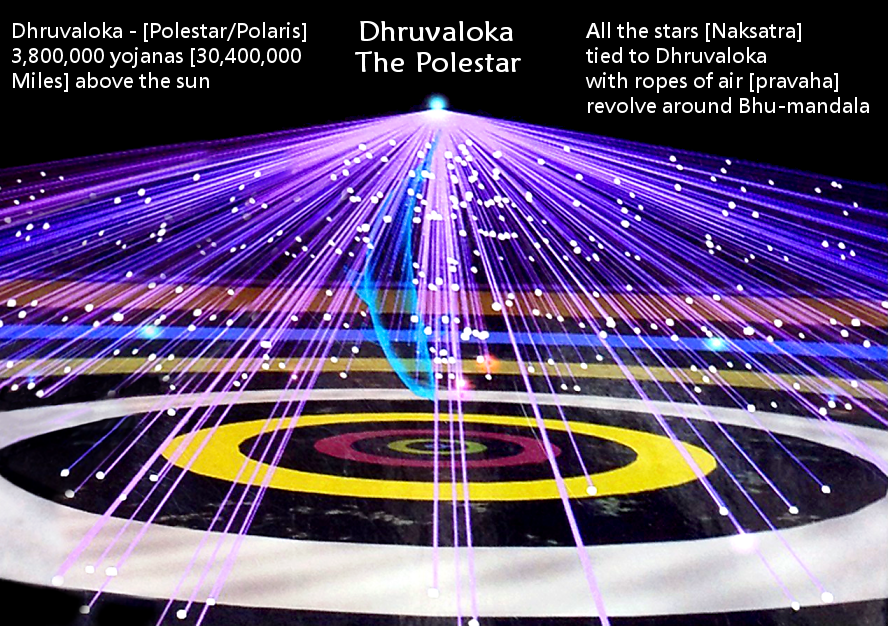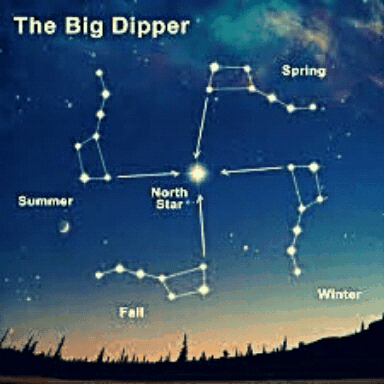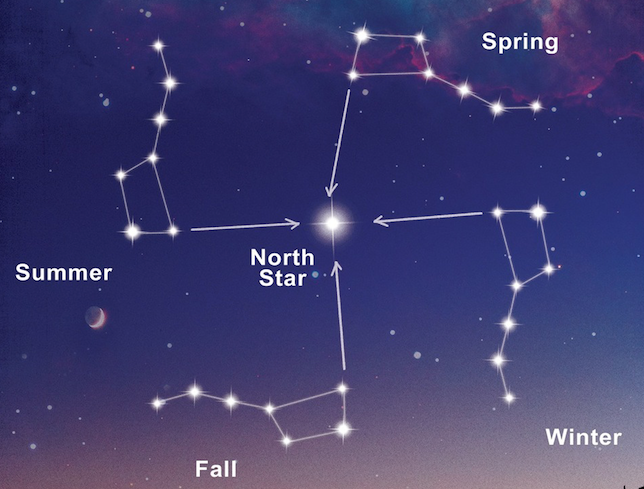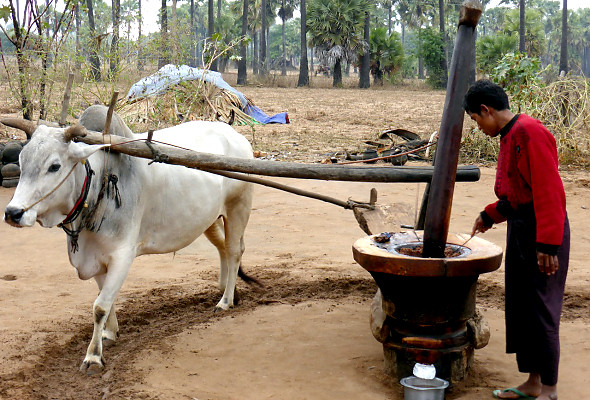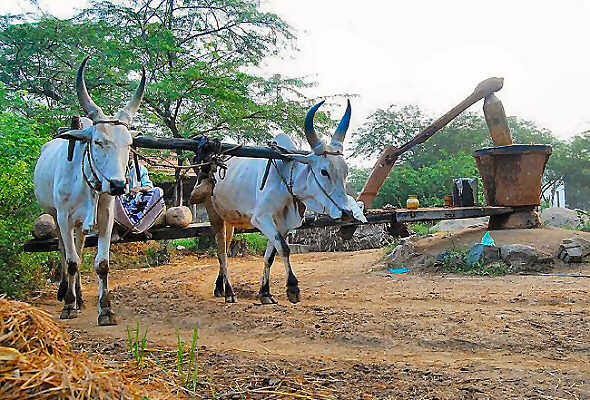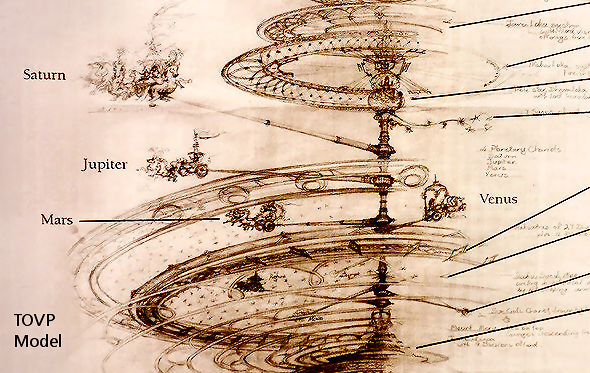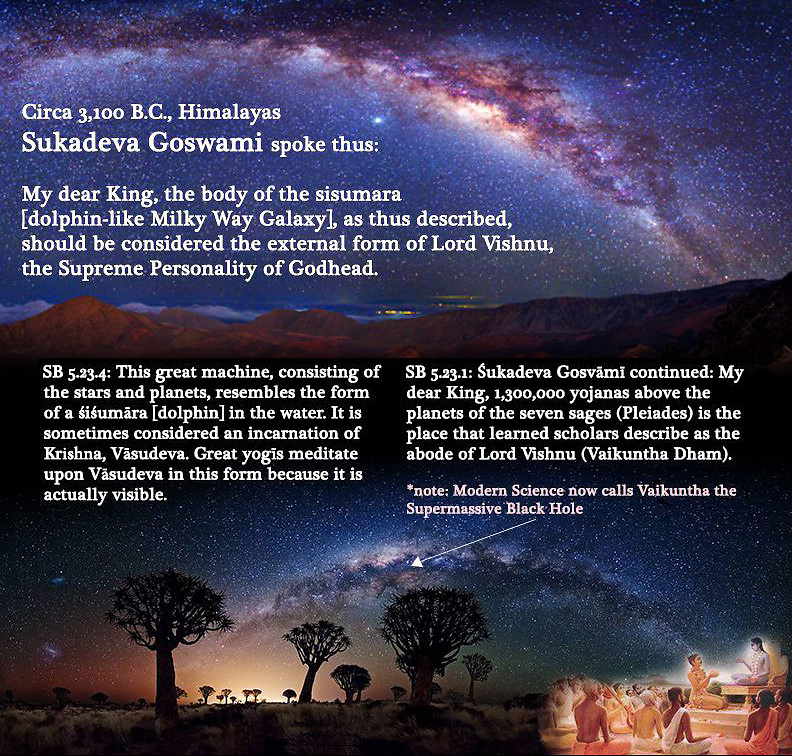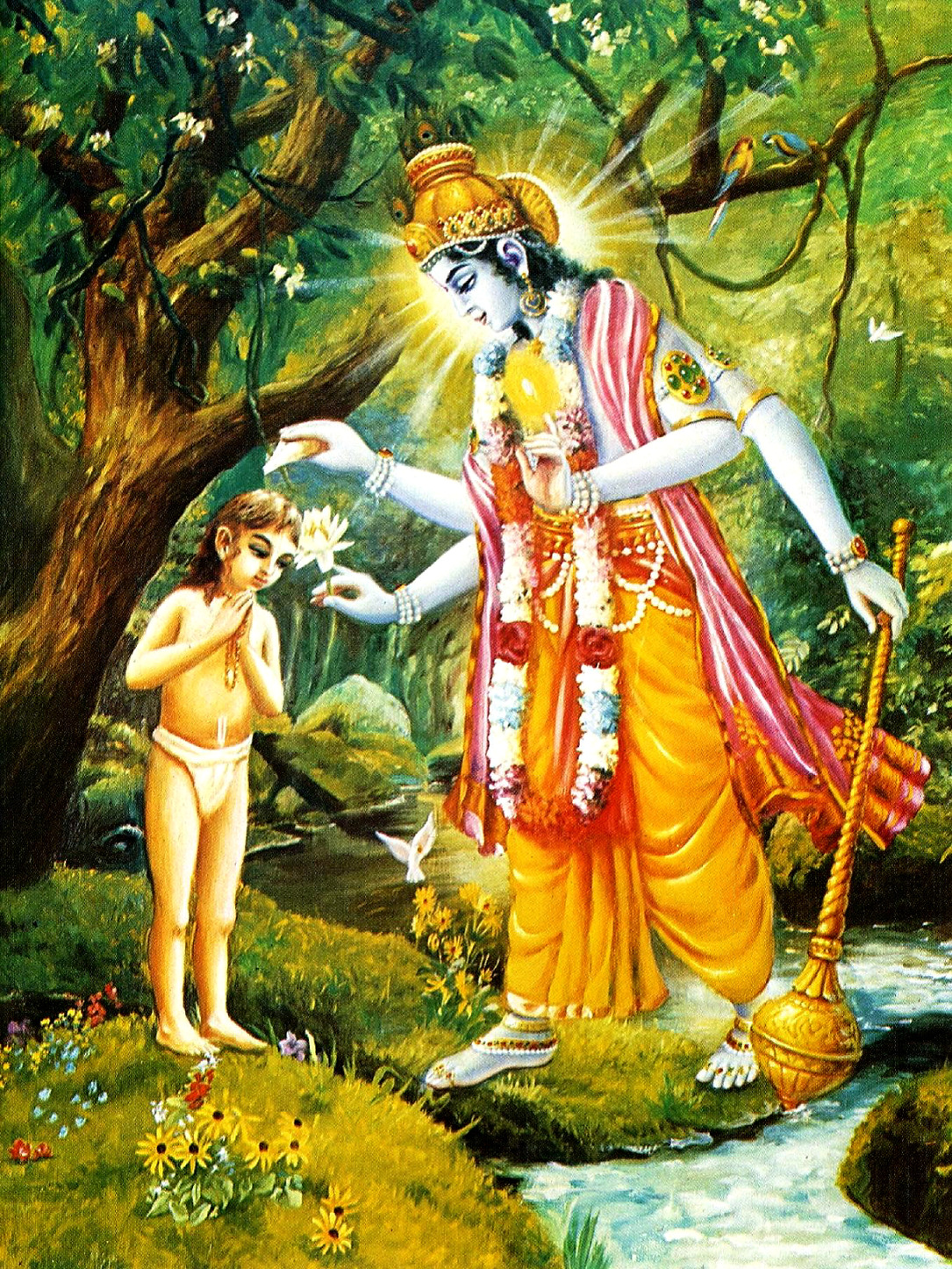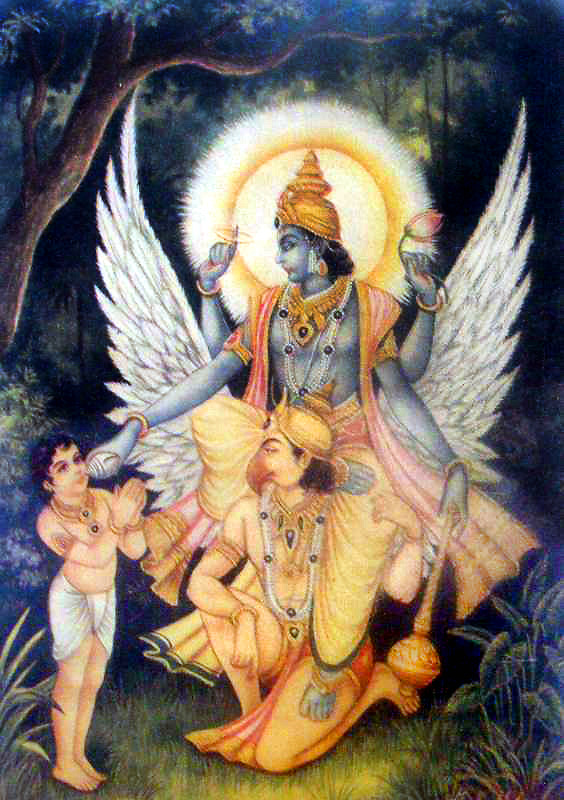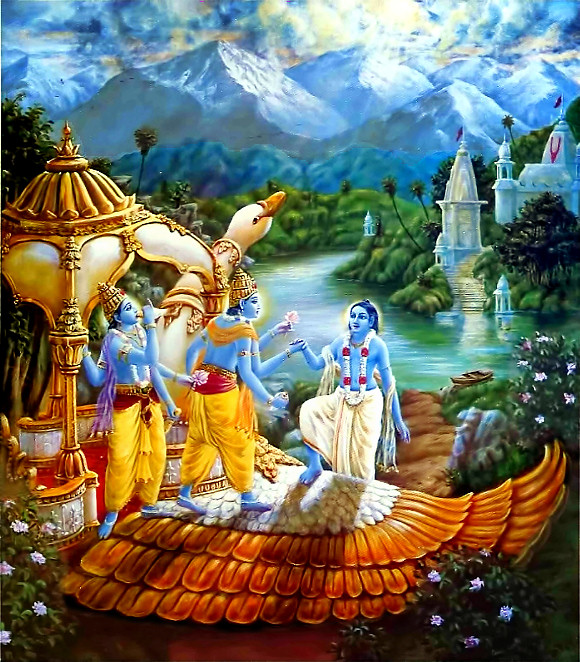
THE POLESTAR - DHRUVA-LOKA
Established by the supreme will of the Supreme Personality of Godhead, the polestar, which is the planet of Mahārāja Dhruva, constantly shines as the central pivot for all the stars and planets. The unsleeping, invisible, most powerful time factor causes these luminaries to revolve around the polestar without cessation. It is distinctly stated herein that all the luminaries, the planets and stars, revolve by the influence of the supreme time factor. The time factor is another feature of the Supreme Personality of Godhead. (sb/5/23/2)
The seven stars revolving around the polestar at the zenith are called saptarṣi-maṇḍala. On these seven stars, (Little Dipper - Seven-Star formation) which form the topmost part of our planetary system, reside seven sages: Kaśyapa, Atri, Vasiṣṭha, Viśvāmitra, Gautama, Jamadagni and Bharadvāja. These seven stars are seen every night, and they each make a complete orbit around the polestar within twenty-four hours. Along with these seven stars, all the others stars also orbit from east to west. The upper portion of the universe is called the north, and the lower portion is called the south. Even in our ordinary dealings, while studying a map, we regard the upper portion of the map as north. (sb/9/16/24)
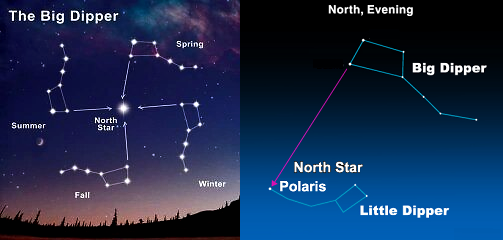
The polar star of the universe and the circle thereof is called the Śiśumāra circle, and therein the local residential planet of the Personality of Godhead (Kṣīrodakaśāyī Viṣṇu) is situated. Before reaching there, the mystic passes over the Milky Way to reach Brahmaloka, and while going there he first reaches Vaiśvānara-loka, where the demigod controls fire. On Vaiśvānara-loka the yogī becomes completely cleansed of all dirty sins acquired while in contact with the material world. The Milky Way in the sky is indicated herein as the way leading to Brahmaloka, the highest planet of the universe. (SB 2.2.24-pp).
According to astronomical calculation, along with the polestar there is another star, which is called Śiśumāra, where Lord Viṣṇu, who is in charge of the maintenance of this material world, resides. Śiśumāra or Dhruvaloka can never be reached by anyone but the Vaiṣṇavas, as will be described by the following ślokas. The associates of Lord Viṣṇu brought the special airplane for Dhruva Mahārāja and then informed him that Lord Viṣṇu had especially sent this airplane. The airplane sent by Lord Viṣṇu to carry Dhruva Mahārāja to Śiśumāra was a completely spiritual, transcendental airplane. (sb/4/12/27)
Each and every planet within the universe travels at a very high speed. From a statement in Śrīmad-Bhāgavatam it is understood that even the sun travels sixteen thousand miles in a second, and from Brahma-saṁhitā we understand from the śloka, yac-cakṣur eṣa savitā sakala-grahāṇām that the sun is considered to be the eye of the Supreme Personality of Godhead, Govinda, and it also has a specific orbit within which it circles. Similarly, all other planets have their specific orbits. But together all of them encircle the polestar, or Dhruvaloka, where Dhruva Mahārāja is situated at the summit of the three worlds. We can only imagine how highly exalted the actual position of a devotee is, and certainly we cannot even conceive how exalted is the position of the Supreme Personality of Godhead. (sb/4/12/39)
All the great sages mentioned in this verse have their planets near Brahmaloka, the planet where Lord Brahmā resides along with four great sages—Sanaka, Sanātana, Sanandana and Sanat-kumāra. These sages reside in different stars known as the southern stars, which circle the polestar. The polestar, called Dhruvaloka, is the pivot of this universe, and all planets move around this polestar. All the stars are planets, as far as we can see, within this one universe. According to Western theory, all the stars are different suns, but according to Vedic information, there is only one sun within this universe. All the so-called stars are but different planets. Besides this universe, there are many millions of other universes, and each of them contains similar innumerable stars and planets. (SB 4.29.42-44 pp)
After purifying the seven planets near Dhruvaloka [the polestar], the Ganges water is carried through the spaceways of the demigods in billions of celestial airplanes. Then it inundates the moon [Candraloka] and finally reaches Lord Brahmā’s abode atop Mount Meru.
We should always remember that the Ganges River comes from the Causal Ocean, beyond the covering of the universe. After the water of the Causal Ocean leaks through the hole created by Lord Vāmanadeva, it flows down to Dhruvaloka (the polestar) and then to the seven planets beneath Dhruvaloka. Then it is carried to the moon by innumerable celestial airplanes, and then it falls to the top of Mount Meru, which is known as Sumeru-parvata. In this way, the water of the Ganges finally reaches the lower planets and the peaks of the Himalayas, and from there it flows through Hardwar and throughout the plains of India, purifying the entire land. How the Ganges water reaches the various planets from the top of the universe is explained herein. Celestial airplanes carry the water from the planets of the sages to other planets. So-called advanced scientists of the modern age are trying to go to the higher planets, but at the same time they are experiencing a power shortage on earth. If they were actually capable scientists, they could personally go by airplane to other planets, but this they are unable to do. Having now given up their moon excursions, they are attempting to go to other planets, but without success. (sb/5/17/4)
Śiśumāra Chakra - wheel of time
Situated 8,800,000 miles above Saturn, or 20,800,000 miles above earth, are the seven saintly sages, who are always thinking of the well-being of the inhabitants of the universe. They circumambulate the supreme abode of Lord Viṣṇu, known as Dhruvaloka, the polestar.
Lord Viṣṇu, who is the source of knowledge and transcendental bliss, has assumed the form of Śiśumāra in the seventh heaven, which is situated in the topmost level of the universe. All the other planets, beginning with the sun, exist under the shelter of this Śiśumāra planetary system. (sb/5/22/17)
This chapter describes how all the planetary systems take shelter of the polestar, Dhruvaloka. It also describes the totality of these planetary systems to be Śiśumāra, another expansion of the external body of the Supreme Personality of Godhead. Dhruvaloka, the abode of Lord Viṣṇu within this universe, is situated 1,300,000 yojanas from the seven stars. In the planetary system of Dhruvaloka are the planets of the fire-god, Indra, Prajāpati, Kaśyapa and Dharma, all of whom are very respectful to the great devotee Dhruva, who lives on the polestar. Like bulls yoked to a central pivot, all the planetary systems revolve around Dhruvaloka, impelled by eternal time. Those who worship the virāṭ-puruṣa, the universal form of the Lord, conceive of this entire rotating system of planets as an animal (dolphin) known as śiśumāra. This imaginary śiśumāra is another form of the Lord. The head of the śiśumāra form is downward, and its body appears like that of a coiled snake. On the end of its tail is Dhruvaloka, on the body of the tail are Prajāpati, Agni, Indra and Dharma, and on the root of the tail are Dhātā and Vidhātā. On its waist are the seven great sages. The entire body of the śiśumāra faces toward its right and appears like a coil of stars. On the right side of this coil are the fourteen prominent stars from Abhijit to Punarvasu, and on the left side are the fourteen prominent stars from Puṣyā to Uttarāṣāḍhā. The stars known as Punarvasu and Puṣyā are on the right and left hips of the śiśumāra, and the stars known as Ārdrā and Aśleṣā are on the right and left feet of the śiśumāra. Other stars are also fixed on different sides of the Śiśumāra planetary system according to the calculations of Vedic astronomers. To concentrate their minds, yogīsworship the Śiśumāra planetary system, which is technically known as the kuṇḍalini-cakra. (SB 5.23 summary)
The body of the Supreme Lord, Viṣṇu, which forms the Śiśumāra-cakra, is the resting place of all the demigods and all the stars and planets. One who chants this mantra to worship that Supreme Person three times a day—morning, noon and evening—will surely be freed from all sinful reactions. If one simply offers his obeisances to this form or remembers this form three times a day, all his recent sinful activities will be destroyed.
नमो ज्योतिर्लोकाय कालायनायानिमिषां
पतये महापुरुषायाभिधीमहीति
namo jyotir-lokāya kālāyanāyānimiṣāṁ
pataye mahā-puruṣāyābhidhīmahīti
“O Lord who has assumed the form of time! O resting place of all the planets moving in different orbits! O master of all demigods, O Supreme Person, I offer my respectful obeisances unto You and meditate upon You.” (sb/5/23/8)
The wheel of time, a gigantic wheel consisting of all the stars, constellations, etc, all fixed in their respective places is connected to the wheel of the chariot of the sun god. It has an axle that rotates once every twenty-four hours. That causes the whole wheel of time to rotate 360 degrees in 24 hours. And this is the rotation that scientists mistakenly presume is the earth rotating. That is what makes the sun and moon and stars rise and set every day.
Moving with the great wheel of time, the stars and constellations travel clockwise around the polestar, and the sun travels with them. The sun, however, encircles the polestar in its own counter clockwise orbit around Sumeru, and therefore the sun’s motion is seen to be different from that of the wheel of time itself. Passing through twelve months, the sun comes in touch with the twelve different signs of the zodiac and assumes twelve different names according to those signs. The aggregate of those twelve months is called a samvatsara, or an entire year.
The sun travels at different speeds. When it travels in its northern course, it travels slowly during the day and quickly at night, thus increasing the duration of the daytime and decreasing the duration of night. When it travels in its southern course, the exact opposite is true— the duration of the day decreases, and the duration of the night increases.
The axle of the sun god’s chariot is resting on the top of Manasottara mountain, which is a huge ring of mountains circling the whole Bhu-mandala island complex. In 360 days the axle of the sun god’s chariot moves all the way around the 360 degrees of the Manasottara mountains. This movement accounts for the different rising and setting positions of the sun, moon and stars, and also accounts for the seasons. So these two movements of the wheel of time, sisumara-chakra, prove that the earth is stationary and everything else is moving around the earth. So that accounts for all the movements we see in the sky that the scientists presume are caused by the earth rotating.
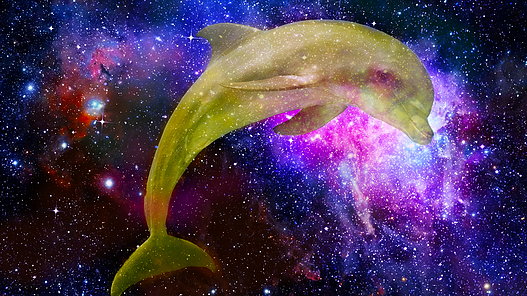
The Śiśumāra Planetary System
All the planetary systems take shelter of the polestar, Dhruvaloka. It also describes the totality of these planetary systems to be Śiśumāra, another expansion of the external body of the Supreme Personality of Godhead. Dhruvaloka, the abode of Lord Viṣṇu within this universe, is situated 1,300,000 yojanasfrom the seven stars. In the planetary system of Dhruvaloka are the planets of the fire-god, Indra, Prajāpati, Kaśyapa and Dharma, all of whom are very respectful to the great devotee Dhruva, who lives on the polestar.
Like bulls yoked to a central pivot, all the planetary systems revolve around Dhruvaloka, impelled by eternal time. Those who worship the virāṭ-puruṣa, the universal form of the Lord, conceive of this entire rotating system of planets as an animal known as śiśumāra. This imaginary śiśumāra is another form of the Lord.
When bulls are yoked together and tied to a central post to thresh rice, they tread around that pivot without deviating from their proper positions—one bull being closest to the post, another in the middle, and a third on the outside. Similarly, all the planets and all the hundreds and thousands of stars revolve around the polestar, the planet of Mahārāja Dhruva, in their respective orbits, some higher and some lower. Fastened by the Supreme Personality of Godhead to the machine of material nature according to the results of their fruitive acts, they are driven around the polestar by the wind and will continue to be so until the end of creation.
These planets float in the air within the vast sky, just as clouds with hundreds of tons of water float in the air or as the great śyena eagles, due to the results of past activities, fly high in the sky and have no chance of falling to the ground. (SB/5/23/3)
"The upper end of this second axle is attached to Dhruvaloka by a rope of wind."
Dhruvaloka, the abode of Lord Viṣṇu within this universe, is situated 1,300,000 yojanasfrom the seven stars. In the planetary system of Dhruvaloka are the planets of the fire-god, Indra, Prajāpati, Kaśyapa and Dharma, all of whom are very respectful to the great devotee Dhruva, who lives on the polestar. Like bulls yoked to a central pivot, all the planetary systems revolve around Dhruvaloka, impelled by eternal time. Those who worship the virāṭ-puruṣa, the universal form of the Lord, conceive of this entire rotating system of planets as an animal known as śiśumāra. [Dolphin]
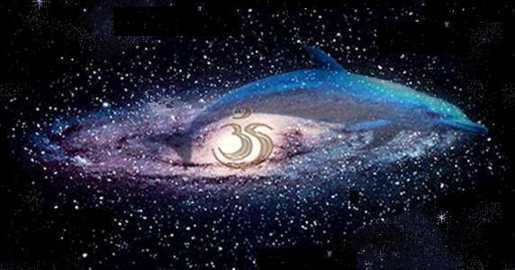
This great machine, consisting of the stars and planets, resembles the form of a śiśumāra [dolphin] in the water. It is sometimes considered an incarnation of Kṛṣṇa, Vāsudeva. Great yogīs meditate upon Vāsudeva in this form because it is actually visible. [SB/5/23/4]
This form of the śiśumāra has its head downward and its body coiled. On the end of its tail is the planet of Dhruva, on the body of its tail are the planets of the demigods Prajāpati, Agni, Indra and Dharma, and at the base of its tail are the planets of the demigods Dhātā and Vidhātā. Where the hips might be on the śiśumāra are the seven saintly sages like Vasiṣṭha and Aṅgirā. The coiled body of the Śiśumāra-cakra turns toward its right side, on which the fourteen constellations from Abhijit to Punarvasu are located. On its left side are the fourteen stars from Puṣyā to Uttarāṣāḍhā. Thus its body is balanced because its sides are occupied by an equal number of stars. On the back of the śiśumāra is the group of stars known as Ajavīthī, and on its abdomen is the Ganges that flows in the sky [the Milky Way]. [SB/5/23/5]
On the right and left sides of where the loins might be on the Śiśumāra-cakra are the stars named Punarvasu and Puṣyā. Ārdrā and Aśleṣā are on its right and left feet, Abhijit and Uttarāṣāḍhā are on its right and left nostrils, Śravaṇā and Pūrvāṣāḍhā are at its right and left eyes, and Dhaniṣṭhā and Mūlā are on its right and left ears. The eight stars from Maghā to Anurādhā, which mark the southern course, are on the ribs of the left of its body, and the eight stars from Mṛgaśīrṣā to Pūrvabhādra, which mark the northern course, are on the ribs on the right side. Śatabhiṣā and Jyeṣṭhā are on the right and left shoulders. [SB/5/23/6]
The head of the śiśumāra form is downward, and its body appears like that of a coiled snake. On the end of its tail is Dhruvaloka, on the body of the tail are Prajāpati, Agni, Indra and Dharma, and on the root of the tail are Dhātā and Vidhātā. On its waist are the seven great sages.
The entire body of the śiśumāra faces toward its right and appears like a coil of stars. On the right side of this coil are the fourteen prominent stars from Abhijit to Punarvasu, and on the left side are the fourteen prominent stars from Puṣyā to Uttarāṣāḍhā. The stars known as Punarvasu and Puṣyā are on the right and left hips of the śiśumāra, and the stars known as Ārdrā and Aśleṣā are on the right and left feet of the śiśumāra. Other stars are also fixed on different sides of the Śiśumāra planetary system according to the calculations of Vedic astronomers. To concentrate their minds, yogīs worship the Śiśumāra planetary system, which is technically known as the kuṇḍalini-cakra.
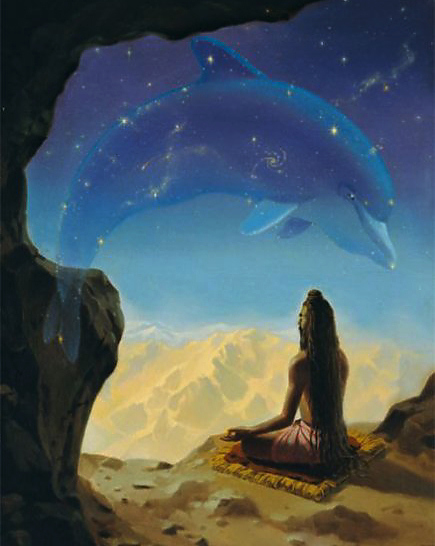
On the upper chin of the śiśumāra is Agasti; on its lower chin, Yamarāja; on its mouth, Mars; on its genitals, Saturn; on the back of its neck, Jupiter; on its chest, the sun; and within the core of its heart, Nārāyaṇa. Within its mind is the moon; on its navel, Venus; and on its breasts, the Aśvinī-kumāras. Within its life air, which is known as prāṇāpāna, is Mercury, on its neck is Rāhu, all over its body are comets, and in its pores are the numerous stars. [SB/5/23/7]
Summarizing the entire description of the planetary systems of the universe, Śrīla Viśvanātha Cakravartī Ṭhākura says that one who is able to meditate upon this arrangement as the virāṭ-rūpa, or viśva-rūpa, the external body of the Supreme Personality of Godhead, and worship Him three times a day by meditation will always be free from all sinful reactions. Viśvanātha Cakravartī Ṭhākura estimates that Dhruvaloka, the polestar, is 3,800,000 yojanas above the sun. Above Dhruvaloka by 10,000,000 yojanas is Maharloka, above Maharloka by 20,000,000 yojanas is Janaloka, above Janaloka by 80,000,000 yojanas is Tapoloka, and above Tapoloka by 120,000,000 yojanas is Satyaloka. Thus the distance from the sun to Satyaloka is 233,800,000 yojanas, or 1,870,400,000 miles. The Vaikuṇṭha planets begin 26,200,000 yojanas(209,600,000 miles) above Satyaloka. Thus the Viṣṇu Purāṇa describes that the covering of the universe is 260,000,000 yojanas (2,080,000,000 miles) away from the sun. The distance from the sun to the earth is lower planetary systems called Atala, Vitala, Sutala, Talātala, Mahātala, Rasātala and Pātāla. Below these lower planets by 30,000 yojanas, Śeṣa Nāga is lying on the Garbhodaka Ocean. That ocean is 249,800,000 yojanas deep. Thus the total diameter of the universe is approximately 500,000,000 yojanas, or 4,000,000,000 miles. (sb/5/23/9)
Those who are righteous in performing devotional service but who are not pure can attain the planetary system of the polestar, or Dhruvaloka, where Dhruva Mahārāja is presiding. He is a great devotee of the Lord, and he has a special planet, which is called the polestar. (Bhagavad-Gita 18.71-purport)
In the upper status of the planetary systems there are facilities thousands and thousands of times greater for material enjoyments than in the lower planetary systems. The topmost planetary systems consist of planets like Brahmaloka and Dhruvaloka (the polestar), and all of them are situated beyond Maharloka. The inhabitants of those planets are empowered with eightfold achievements of mystic perfection. They do not have to learn and practice the mystic processes of yoga perfection and achieve the power of becoming small like a particle (aṇimā-siddhi), or lighter than a soft feather (laghimā-siddhi). They do not have to get anything and everything from anywhere and everywhere (prāpti-siddhi), to become heavier than the heaviest (mahimā-siddhi), to act freely even to create something wonderful or to annihilate anything at will (īśitva-siddhi), to control all material elements (vaśitva-siddhi), to possess such power as will never be frustrated in any desire (prākāmya-siddhi), or to assume any shape or form one may even whimsically desire (kāmāvasāyitā-siddhi). All these expediencies are as common as natural gifts for the inhabitants of those higher planets. They do not require any mechanical help to travel in outer space, and they can move and travel at will from one planet to any other planet within no time. The inhabitants of the earth cannot move even to the nearest planet except by mechanical vehicles like spacecraft, but the highly talented inhabitants of such higher planets can do everything very easily. (SB 2.2.22-pp).
The individual soul is forever a servant of the Supersoul, and therefore his relationship with the Supersoul is to offer service. That is called bhakti-yoga, or bhakti-bhāva. Dhruva Mahārāja offered his prayers to the Lord not in the way of the impersonalist philosophers, but as a devotee. Therefore, it is clearly said here, bhakti-bhāva. The only prayers worth offering are those offered to the Supreme Personality of Godhead, whose reputation is spread far and wide. Dhruva Mahārāja wanted to have the kingdom of his father, but his father refused even to allow him to get on his lap. In order to fulfill his desire, the Lord had already created a planet known as the polestar, Dhruvaloka, which was never to be annihilated even at the time of the dissolution of the universe. Dhruva Mahārāja attained this perfection not by acting hastily, but by patiently executing the order of his spiritual master, and therefore he became so successful that he saw the Lord face to face. Now he was further enabled, by the causeless mercy of the Lord, to offer fitting prayers to the Lord. To glorify or offer prayers unto the Supreme, one needs the Lord’s mercy. One cannot write to glorify the Lord unless one is endowed with His causeless mercy. (sb/4/9/5)
The Supreme Personality of Godhead continued: My dear Dhruva, I shall award you the glowing planet known as the polestar, which will continue to exist even after the dissolution at the end of the millennium. No one has ever ruled this planet, which is surrounded by all the solar systems, planets and stars. All the luminaries in the sky circumambulate this planet, just as bulls tread around a central pole for the purpose of crushing grains. Keeping the polestar to their right, all the stars inhabited by the great sages like Dharma, Agni, Kaśyapaand Śukra circumambulate this planet, which continues to exist even after the dissolution of all others.
Although the polestar existed before its occupation by Dhruva Mahārāja, it had no predominating deity. Dhruvaloka, our polestar, is the center for all other stars and solar systems, for all of them circle around Dhruvaloka just as a bull crushes grains by walking around and around a central pole. Dhruva wanted the best of all planets, and although it was a childish prayer, the Lord satisfied his demand. A small child may demand something from his father which his father has never given to anyone else, yet out of affection the father offers it to the child; similarly, this unique planet, Dhruvaloka, was offered to Mahārāja Dhruva. The specific significance of this planet is that until the entire universe is annihilated this planet will remain, even during the devastation which takes place during the night of Lord Brahmā. There are two kinds of dissolutions, one during the night of Lord Brahmā and one at the end of Lord Brahmā’s life. At the end of Brahmā’s life, selected personalities go back home, back to Godhead. Dhruva Mahārāja is one of them. The Lord assured Dhruva that he would exist beyond the partial dissolution of this universe. Thus at the end of the complete dissolution, Dhruva Mahārāja would go directly to Vaikuṇṭhaloka, to a spiritual planet in the spiritual sky. Śrīla Viśvanātha Cakravartī Ṭhākura comments in this connection that Dhruvaloka is one of the lokas like Śvetadvīpa, Mathurā and Dvārakā. They are all eternal places in the kingdom of Godhead, which is described in the Bhagavad-gītā(tad dhāma paramam) and in the Vedas (oṁ tad viṣṇoḥparamaṁ padaṁ sadā paśyanti sūrayaḥ). The words parastāt kalpa-vāsinām, “transcendental to the planets inhabited after the dissolution,” refer to the Vaikuṇṭha planets. In other words, Dhruva Mahārāja’s promotion to the Vaikuṇṭhalokas was guaranteed by the Supreme Personality of Godhead. (sb/4/9/20-21)
In this verse the word nāvartate is very significant. The Lord says, “You will not come back to this material world, for you will reach mat-sthānam, My abode.” Therefore Dhruvaloka, or the polestar, is the abode of Lord Viṣṇu within this material world. Upon it there is an ocean of milk, and within that ocean there is an island known as Śvetadvīpa. It is clearly indicated that this planet is situated above the seven planetary systems of the ṛṣis, and because this planet is Viṣṇuloka, it is worshiped by all other planetary systems. It may be questioned here what will happen to the planet known as Dhruvaloka at the time of the dissolution of this universe. The answer is simple: Dhruvaloka remains, like other Vaikuṇṭhalokas beyond this universe. Śrīla Viśvanātha Cakravartī Ṭhākura has commented in this connection that the very word nāvartate indicates that this planet is eternal. (sb/4/9/25)
Dhruva goes back home back to Godhead
In Badarikāśrama Dhruva Mahārāja’s senses became completely purified because he bathed regularly in the crystal-clear purified water. He fixed his sitting position and by yogic practice controlled the breathing process and the air of life; in this way his senses were completely withdrawn. Then he concentrated his mind on the arcā-vigraha form of the Lord, which is the exact replica of the Lord and, thus meditating upon Him, entered into complete trance. (sb/4/12/17)
Because of his transcendental bliss, incessant tears flowed from his eyes, his heart melted, and there was shivering and standing of the hairs all over his body. Thus transformed, in a trance of devotional service, Dhruva Mahārāja completely forgot his bodily existence, and thus he immediately became liberated from material bondage. As soon as the symptoms of his liberation were manifest, he saw a very beautiful airplane coming down from the sky, as if the brilliant full moon were coming down, illuminating all the ten directions. (sb/4/12/19)
Dhruva Mahārāja saw two very beautiful associates of Lord Viṣṇu in the plane. They had four hands and a blackish bodily luster, they were very youthful, and their eyes were just like reddish lotus flowers. They held clubs in their hands, and they were dressed in very attractive garments with helmets and were decorated with necklaces, bracelets and earrings. (sb/4/12/20)
The inhabitants of Viṣṇuloka are of the same bodily feature as Lord Viṣṇu, and they also hold club, conchshell, lotus flower and disc. In this verse it is distinctly stated that they had four hands and were nicely dressed; the description of their bodily decorations corresponds exactly to that of Viṣṇu. So the two uncommon personalities who descended from the airplane came directly from Viṣṇuloka, or the planet where Lord Viṣṇu lives.
Dhruva Mahārāja, seeing that these uncommon personalities were direct servants of the Supreme Personality of Godhead, immediately stood up. But, being puzzled, in hastiness he forgot how to receive them in the proper way. Therefore he simply offered obeisances with folded hands and chanted and glorified the holy names of the Lord. (sb/4/12/21)
Nanda and Sunanda, the two confidential associates of Lord Viṣṇu, said: Dear King, let there be all good fortune unto you. Please attentively hear what we shall say. When you were only five years old, you underwent severe austerities, and you thereby greatly satisfied the Supreme Personality of Godhead. We are representatives of the Supreme Personality of Godhead, the creator of the whole universe, who carries in His hand the bow named Śārṅga. We have been specifically deputed to take you to the spiritual world. (sb/4/12/24)
Dear King Dhruva, neither your forefathers nor anyone else before you ever achieved such a transcendental planet. The planet known as Viṣṇuloka, where Lord Viṣṇupersonally resides, is the highest of all. It is worshipable by the inhabitants of all other planets within the universe. Please come with us and live there eternally. (sb/4/12/26)
Before getting aboard, Dhruva Mahārāja worshiped the airplane, circumambulated it, and also offered obeisances to the associates of Viṣṇu. In the meantime he became as brilliant and illuminating as molten gold. He was thus completely prepared to board the transcendental plane. While boarding the Vaikuṇṭha airplane, his body changed to a completely spiritual golden hue. No one can surpass the higher planets in a material body, but when one gets a spiritual body he can travel not only to the higher planetary system of this material world, but even to the still higher planetary system known as Vaikuṇṭhaloka. It is well known that Nārada Muni travels everywhere, both in the spiritual and material worlds.
While Dhruva Mahārāja was passing through space, he gradually saw all the planets of the solar system, and on the path he saw all the demigods in their airplanes showering flowers upon him like rain. Dhruva Mahārāja thus surpassed the seven planetary systems of the great sages who are known as saptarṣi. Beyond that region, he achieved the transcendental situation of permanent life in the planet where Lord Viṣṇu lives. (sb/4/12/35)
